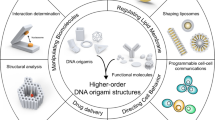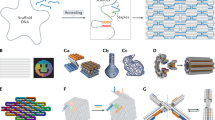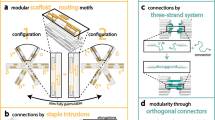Single-molecule chemical reactions on DNA origami (original) (raw)
- Letter
- Published: 28 February 2010
- Thomas Tørring1,2,
- Alexandru Rotaru1,2,
- Mikkel F. Jacobsen1,2,
- Jens B. Ravnsbæk1,2,
- Ramesh Subramani1,3,
- Wael Mamdouh1,3,
- Jørgen Kjems1,4,
- Andriy Mokhir5,
- Flemming Besenbacher1,3 &
- …
- Kurt Vesterager Gothelf1,2
Nature Nanotechnology volume 5, pages 200–203 (2010)Cite this article
- 10k Accesses
- 501 Citations
- 16 Altmetric
- Metrics details
Subjects
Abstract
DNA nanotechnology1,2 and particularly DNA origami3, in which long, single-stranded DNA molecules are folded into predetermined shapes, can be used to form complex self-assembled nanostructures4,5,6,7,8,9,10. Although DNA itself has limited chemical, optical or electronic functionality, DNA nanostructures can serve as templates for building materials with new functional properties. Relatively large nanocomponents such as nanoparticles and biomolecules can also be integrated into DNA nanostructures and imaged11,12,13. Here, we show that chemical reactions with single molecules can be performed and imaged at a local position on a DNA origami scaffold by atomic force microscopy. The high yields and chemoselectivities of successive cleavage and bond-forming reactions observed in these experiments demonstrate the feasibility of post-assembly chemical modification of DNA nanostructures and their potential use as locally addressable solid supports.
This is a preview of subscription content, access via your institution
Access options
Subscribe to this journal
Receive 12 print issues and online access
$259.00 per year
only $21.58 per issue
Buy this article
- Purchase on SpringerLink
- Instant access to full article PDF
Prices may be subject to local taxes which are calculated during checkout
Additional access options:
Similar content being viewed by others


DNA origami
Article 28 January 2021

References
- Seeman, N. C. An overview of structural DNA nanotechnology. Mol. Biotechnol. 37, 246–257 (2007).
Article CAS Google Scholar - Gothelf, K. V. & LaBean, T. H. DNA-programmed assembly of nanostructures. Org. Biomol. Chem. 23, 4023–4037 (2005).
Article Google Scholar - Rothemund, P. W. K. Folding DNA to create nanoscale shapes and patterns. Nature 440, 297–302 (2006).
Article CAS Google Scholar - Qian, L. et al. Analogic China map constructed by DNA. Chin. Sci. Bull. 51, 2973–2976 (2006).
Article CAS Google Scholar - Andersen, E. S. et al. DNA origami design of dolphin-shaped structures with flexible tails. ACS Nano 2, 1213–1218 (2008).
Article CAS Google Scholar - Andersen, E. S. et al. Self-assembly of a nanoscale DNA box with a controllable lid. Nature 459, 73–76 (2009).
Article CAS Google Scholar - Ke, Y. et al. Scaffolded DNA origami of a DNA tetrahedron molecular container. Nano Lett. 9, 2445–2447 (2009).
Article CAS Google Scholar - Kuzuya, A. & Komiyama, M. Design and construction of a box-shaped 3D-DNA origami. Chem. Commun. 4182–4184 (2009).
- Douglas, S. M. et al. Self-assembly of DNA into nanoscale three-dimensional shapes. Nature 459, 414–418 (2009).
Article CAS Google Scholar - Dietz, H., Douglas, S. M. & Shih, W. M. Folding DNA into twisted and curved nanoscale shapes. Science 325, 725–730 (2009).
Article CAS Google Scholar - LaBean, T. & Li, H. Using DNA for construction of novel materials. Nano Today 2, 26–35 (2007).
Article Google Scholar - Rinker, S., Ke, Y., Liu, Y., Chhabra, R. & Yan, H. Self-assembled DNA nanostructures for distance-dependent multivalent ligand–protein binding. Nature Nanotech. 3, 418–422 (2008).
Article CAS Google Scholar - Ke, Y., Lindsay, S., Chang, Y., Liu, Y. & Yan, H. Self-assembled water-soluble nucleic acid probe tiles for label-free RNA hybridization assays. Science 319, 180–183 (2008).
Article CAS Google Scholar - Chhabra, R. et al. Spatially addressable multiprotein nanoarrays templated by aptamer-tagged DNA nanoarchitectures. J. Am. Chem. Soc. 129, 10304–10305 (2007).
Article CAS Google Scholar - Yan, H., Park, S. H., Finkelstein, G., Reif, J. & LaBean, T. H. DNA-templated self-assembly of protein arrays and highly conductive nanowires. Science 301, 1882–1884 (2003).
Article CAS Google Scholar - Lund, K., Liu, Y., Lindsay, S. & Yan, H. Self-assembling a molecular pegboard. J. Am. Chem. Soc. 127, 17606–17607 (2005).
Article CAS Google Scholar - Park, S.-H. K. et al. Finite-size, fully addressable DNA tile lattices formed by hierarchical assembly procedures. Angew. Chem. Int. Ed. 45, 735–739 (2006).
Article CAS Google Scholar - Park, S.-H. et al. Programmable DNA self-assemblies for nanoscale organization of ligands and proteins. Nano Lett. 5, 729–733 (2005).
Article CAS Google Scholar - Kuzuya, A. et al. Precisely programmed and robust 2D streptavidin nanoarrays by using periodical nanometer-scale wells embedded in DNA origami assembly. ChemBioChem 10, 1811–1815 (2009).
Article CAS Google Scholar - Kuzyk, A., Laitinen, K. T. & Törmä, P. DNA origami as a nanoscale template for protein assembly. Nanotechnology 20, 235305 (2009).
Article Google Scholar - Baugh, S. D. P., Yang, Z., Leung, D. K., Wilson, D. M. & Breslow, R. Cyclodextrin dimers as cleavable carriers of photodynamic sensitizers. J. Am. Chem. Soc. 123, 12488–12494 (2001).
Article CAS Google Scholar - Rotaru, A. & Mokhir, A. Nucleic acid binders activated by light of selectable wavelength. Angew. Chem. Int. Ed. 46, 6180–6183 (2007).
Article CAS Google Scholar - Tornøe, C. W., Christensen, C. & Meldal, M. Peptidotriazoles on solid phase: [1,2,3]-triazoles by regiospecific copper(i)-catalyzed 1,3-dipolar cycloadditions of terminal alkynes to azides. J. Org. Chem. 67, 3057–3064 (2002).
Article Google Scholar - Rostovtsev, V. V., Green, L. G., Fokin, V. V. & Sharpless, K. B. A stepwise huisgen cycloaddition process: copper(I)-catalyzed regioselective ‘ligation’ of azides and terminal alkynes. Angew. Chem. Int. Ed. 41, 2596–2599 (2002).
Article CAS Google Scholar - Chan, T. R., Hilgraf, R., Sharpless, K. B. & Fokin, V. V. Polytriazoles as copper(I)-stabilizing ligands in catalysis. Org. Lett. 6, 2853–2855 (2004).
Article CAS Google Scholar - van Kasteren, I. et al. Expanding the diversity of chemical protein modification allows post-translational mimicry. Nature 446, 1105–1109 (2007).
Article CAS Google Scholar - Schweitzer, C. & Schmidt, R. Physical mechanisms of generation and deactivation of singlet oxygen. Chem. Rev. 103, 1685–1758 (2003).
Article CAS Google Scholar - Gothelf, K. V. et al. Modular DNA-programmed assembly of linear and branched conjugated nanostructures. J. Am. Chem. Soc. 126, 1044–1046 (2004).
Article CAS Google Scholar - Andersen, C. S., Yan, H. & Gothelf, K. V. Bridging one helical turn in double-stranded DNA by templated dimerization of molecular rods. Angew. Chem. Int. Ed. 47, 5569–5572 (2008).
Article CAS Google Scholar
Acknowledgements
The authors would like to thank V. Birkedal and T. LaBean for valuable comments regarding the manuscript. This work was supported by grants from the Danish National Research Foundation to the CDNA centre and the Danish Research Agency through support for the iNANO Center.
Author information
Authors and Affiliations
- Centre for DNA Nanotechnology (CDNA) at the Interdisciplinary Nanoscience Center (iNANO), Aarhus University, Aarhus C, DK-8000, Denmark
Niels V. Voigt, Thomas Tørring, Alexandru Rotaru, Mikkel F. Jacobsen, Jens B. Ravnsbæk, Ramesh Subramani, Wael Mamdouh, Jørgen Kjems, Flemming Besenbacher & Kurt Vesterager Gothelf - Department of Chemistry, Aarhus University, Aarhus C, DK-8000, Denmark
Niels V. Voigt, Thomas Tørring, Alexandru Rotaru, Mikkel F. Jacobsen, Jens B. Ravnsbæk & Kurt Vesterager Gothelf - Department of Physics and Astronomy, Aarhus University, Aarhus C, DK-8000, Denmark
Ramesh Subramani, Wael Mamdouh & Flemming Besenbacher - Department of Molecular Biology, Aarhus University, Aarhus C, DK-8000, Denmark
Jørgen Kjems - Institute of Inorganic Chemistry, Ruprecht-Karls University, Heidelberg, Germany
Andriy Mokhir
Authors
- Niels V. Voigt
- Thomas Tørring
- Alexandru Rotaru
- Mikkel F. Jacobsen
- Jens B. Ravnsbæk
- Ramesh Subramani
- Wael Mamdouh
- Jørgen Kjems
- Andriy Mokhir
- Flemming Besenbacher
- Kurt Vesterager Gothelf
Contributions
N.V.V., T.T. and A.R. contributed equally to the design and execution of the experiments. M.F.J. and J.B.R. synthesized some of the organic compounds. R.S. and W.M. assisted in the AFM imaging. A.M. provided Linker C. J.K. and F.B. advised on the project. K.V.G. directed the project and co-wrote the manuscript. All authors discussed the results and commented on the manuscript.
Corresponding author
Correspondence toKurt Vesterager Gothelf.
Ethics declarations
Competing interests
The authors declare no competing financial interests.
Supplementary information
Rights and permissions
About this article
Cite this article
Voigt, N., Tørring, T., Rotaru, A. et al. Single-molecule chemical reactions on DNA origami.Nature Nanotech 5, 200–203 (2010). https://doi.org/10.1038/nnano.2010.5
- Received: 03 September 2009
- Accepted: 14 January 2010
- Published: 28 February 2010
- Issue Date: March 2010
- DOI: https://doi.org/10.1038/nnano.2010.5
This article is cited by
Site-directed placement of three-dimensional DNA origami
- Irina V. Martynenko
- Elisabeth Erber
- Tim Liedl
Nature Nanotechnology (2023)
Functionalizing DNA origami to investigate and interact with biological systems
- Grant A. Knappe
- Eike-Christian Wamhoff
- Mark Bathe
Nature Reviews Materials (2022)
DNA origami
- Swarup Dey
- Chunhai Fan
- Pengfei Zhan
Nature Reviews Methods Primers (2021)
Hybrid material of structural DNA with inorganic compound: synthesis, applications, and perspective
- Seung Won Shin
- Ji Soo Yuk
- Soong Ho Um
Nano Convergence (2020)
Proximity-induced caspase-9 activation on a DNA origami-based synthetic apoptosome
- Bas J. H. M. Rosier
- Albert J. Markvoort
- Tom F. A. de Greef
Nature Catalysis (2020)